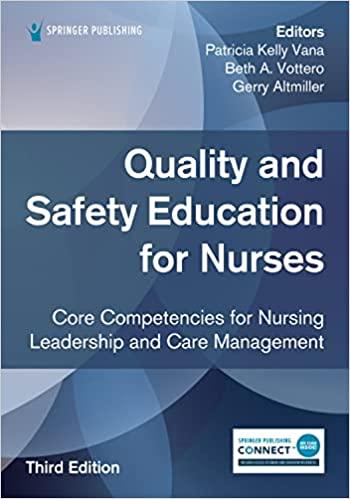A school nurse in a large high school in Chicago, Illinois, has noticed teens coming to the
Question:
A school nurse in a large high school in Chicago, Illinois, has noticed teens coming to the clinic with unusual mouth sores and/or an unexplained cough. After researching potential causes of these findings, the nurse recognizes that these symptoms are common side effects of vaping (i.e., the use of electronic vapor products). She brings her concerns to the school administration and finds out that the administration has also noted an increase in student use of electronic vapor products. In the past 6 months, the school has had a 15% increase in student discipline issues related to vaping or the use of electronic vapor products. Wanting to research more statistical information, the nurse reviews the report of the local Community Health Needs Assessment (CHNA), an assessment process in which local health departments, hospitals, and community partners collect, analyze, and summarize health data and prioritize the health-related needs of the community. The CHNA report notes the reported use of electronic vaping products has increased between 2017 and 2019 based on survey results from the Centers for Disease Control and Prevention (CDC) Local Youth Risk Behavior Surveillance Survey (YRBS; Alliance for Health Equality, 2019. The nurse decides to investigate further by reviewing YRBS data directly on the CDC website. She reviews data for Chicago and finds an increase from 6.6% of students reporting current electronic vapor use in 2017 to 12.4% reporting current use in 2019. The nurse also finds that the concern is not just local; vaping among high school students has increased from 13.2% in 2017 to 19.9% in 2019 in the state of Illinois (CDC, n.d.-a). This finding supports the school nurse’s clinical observations. It inspires the nurse to create some initiatives at the school to educate the teens about the risks of electronic vapor products; inform parents, teachers, and administrators of signs of electronic vapor use; and explore ways to motivate the student population to either stop the behavior or never start using the vapor products in the first place.
1.
Use the website: www.cdc.gov/healthyyouth/data/yrbs/results.htm. Scroll to the “State and National Comparisons” section and check the Youth Risk Behavior Surveillance Survey data for your state. What population health needs did you find for your state?
2.
Do a web search for a CHNA done in your community. Nonprofit hospitals and local health departments typically make the reports available online to community members. What are some of the population health issues identified in your community?
3.
How can CHNA and the YRBS assist nurses to address community population health needs?
Step by Step Answer:

Quality And Safety Education For Nurses Core Competencies For Nursing Leadership And Care Management
ISBN: 9780826161444
3rd Edition
Authors: Patricia Kelly Vana, Beth A. Vottero, Gerry Altmiller






